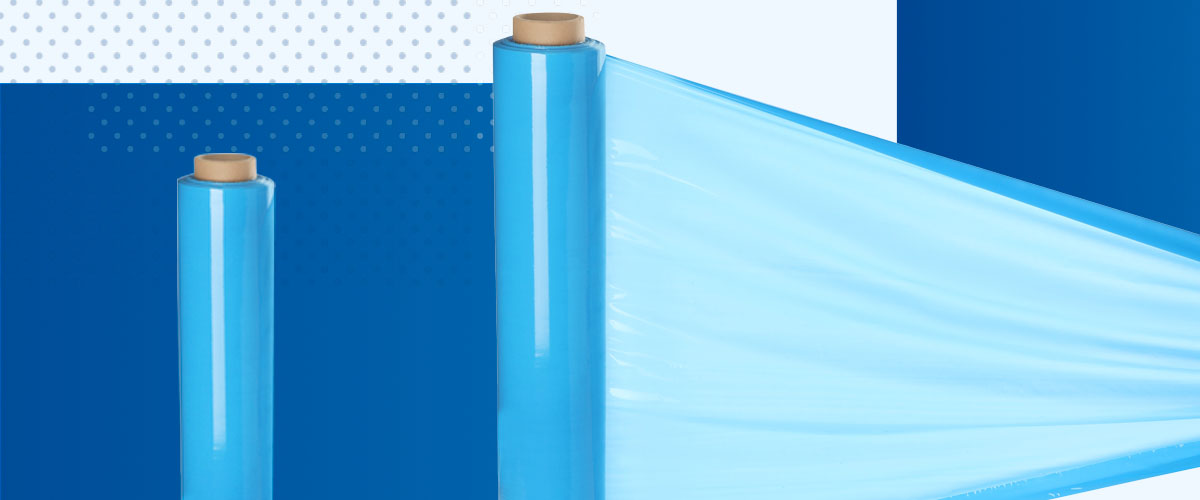Keeping metals corrosion-free is a persistent challenge across manufacturing, shipping and storage. Exposure to contaminants can diminish product quality and value.
Traditional methods, such as oils and grease, have long been used to address this problem, but they result in messy applications and limited long-term effectiveness.
Volatile corrosion inhibitor (VCI) packaging creates a clean, invisible shield against tarnish. It can be a viable rust prevention packaging solution for industries looking to maintain product quality and protect sensitive equipment.
What Is a VCI?
A VCI is a chemical compound that protects metals from corrosion. VCIs function in vapor form, and when released in an enclosed space, these molecules disperse into the surrounding space and settle onto exposed metal surfaces. Once in contact, they form an ultra-thin, invisible film that prevents chemical reactions that cause rust.
VCIs help companies ship precision parts and heavy machinery, knowing that the metal’s integrity will remain intact.
Understanding Corrosion
Corrosion occurs when oxygen and moisture interact with a metal surface, triggering electrochemical reactions that lead to rust or tarnish. The process is driven by the following microscopic differences on the metal surface:
- Anodic reactions: At anodic sites, iron atoms lose electrons and turn into ferrous ions.
- Cathodic reactions: At cathodic sites, electrons combine with oxygen and water, producing hydroxy ions.
- Role of moisture and oxygen: Water acts as an electrolyte, speeding up the flow of electrons. Oxygen sustains the reaction, leading to corrosion.
- Impact on metal integrity: These reactions eat away at the surface, weakening the structure, impairing performance and reducing a product’s lifespan.
Traditional Industrial Corrosion Prevention Methods
For decades, industries relied on the following physical barriers and environmental controls:
- Oil and grease-based coatings create a hydrophobic layer on a surface. They work, but are messy and require removal before use. Oils and greases increase labor and pose safety or environmental handling issues.
- Rust preventatives, such as temporary sprays or waxes, protect against moisture. However, they often fail to reach hidden areas and can degrade in long-term storage or under temperature swings.
- Dehumidification systems have climate control properties, which reduce risk in storage facilities. That said, they are impractical during transit because they’re most effective in fixed locations.
VCIs provide the same corrosion prevention benefits without creating bottlenecks in assembly lines or logistics operations. The molecular vapor system delivers cleaner and more efficient protection.
What Is VCI Packaging?
VCI packaging is packing made of materials infused or coated with VCI. These materials release VCIs in a controlled way, saturating the enclosed space and forming a protective barrier for metals.
When metal components are wrapped or sealed inside VCI packaging, the inhibitors slowly vaporize and spread throughout the container. This process ensures the protective molecules reach every exposed surface.
Because the protection is created by a vapor, it is self-adjusting. If the packaging is opened, molecules that escape are naturally replaced by others still embedded in the packaging material.
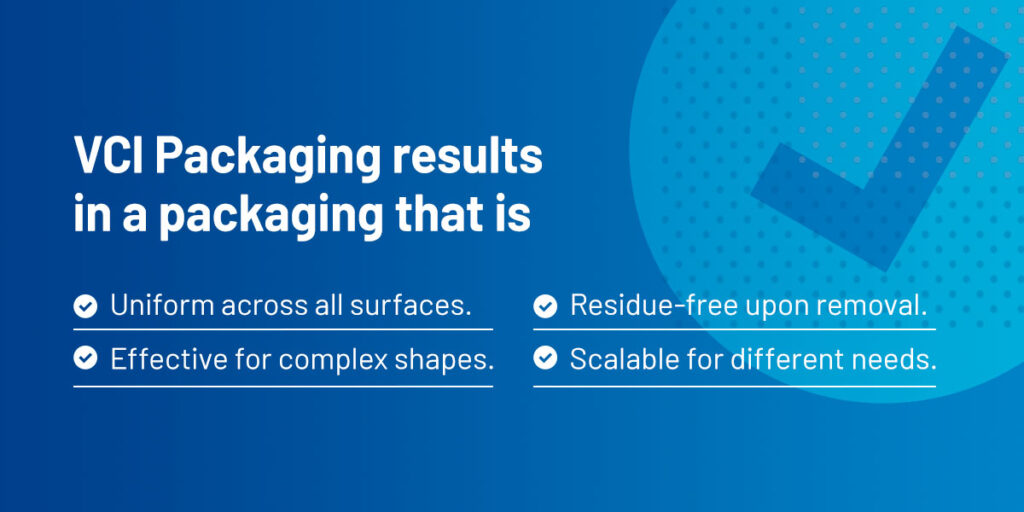
The result is packaging that is:
- Uniform across all surfaces.
- Effective for complex shapes.
- Residue-free upon removal.
- Scalable for different needs.
How Does VCI Packaging Work
The strength of VCI packaging lies in how the vapor phase inhibitors behave inside an enclosed space. Here’s how it delivers protection to different shapes and settings:
- Vapor phase corrosion inhibitor mechanism: Once sealed in a package, the molecules slowly vaporize and disperse into the airspace. This vapor fills the enclosure and seeks out exposed metal surfaces. Because the molecules move in gas form, they can access areas where liquids or coatings would struggle to reach.
- Molecular shield formation: When the vapor molecules come into contact with metal, they bond to the surface and create a monomolecular shield. This protective layer disrupts the electrochemical pathways that normally allow corrosion to occur.
- Protection in enclosed spaces: VCIs require a sealed or semi-sealed environment to remain effective. Once inside, the space becomes saturated with inhibitor molecules, maintaining consistent protection. If the enclosure is opened, some molecules escape, but the packaging material continues releasing new vapor to restore equilibrium.
Chemical Properties of VCI Packaging
VCI molecules are amines, carboxylic acids or proprietary blends formulated to target ferrous and nonferrous metals. Molecules absorb onto a metal surface, preventing moisture and oxygen from initiating anodic and cathodic reactions. The barrier is nanometers thin but blocks the electron flow necessary for corrosion to advance.
When the packaging is removed, the molecules naturally dissipate. The surface is left residue-free, ready for assembly or finishing.
Types of VCI Packaging Materials
VCI packaging comes in several formats, each tailored to meet specific handling and environmental needs.
VCI Papers
VCI paper is a polyethylene-based or kraft paper with corrosion inhibitors. Manufacturers often produce them in sheets, rolls or precut forms, making it simple to wrap irregular parts or place between stacked items. VCI paper excels in situations where adaptability matters, such as wrapping uniquely shaped items or interleaving between stacked parts.
VCI paper is advantageous because it is:
- Biodegradable and more eco-friendly than plastic-based alternatives.
- Cost-effective for short-term protection or for items that are handled frequently.
- Lightweight and flexible for quick handling.
However, there are limitations to be aware of. The porous structure provides less of a barrier against moisture than film or bags. It’s best suited for shorter durations unless used inside a sealed enclosure.
VCI Bags
VCI bags are manufactured from polyethylene or sometimes blended with polyester. They are available as:
- Flat bags.
- Gusseted bags.
- Resealable zipper bags.
- Military-specific formats.
Similar to VCI papers, VCI bags work by producing rust protection molecules. They are best suited for long-term storage or overseas shipping because their barrier strength and chemical protection allow them to perform well under fluctuating humidity and temperature. The bags can be heat-sealed to improve contamination prevention.
VCI Films
VCI film is polyethylene-based and produced in heavier gauges for strength. It’s supplied as rolls or sheets, making it adaptable for small parts and oversized equipment. VCI film offers strong puncture resistance, which is ideal for wrapping machinery or large assemblies that cannot fit into bags.
Metal Protection Capabilities of VCI Packaging
VCI packaging protects ferrous and nonferrous metals, creating a flexible solution for industries that work with various materials.
Ferrous Metals
Ferrous metals contain iron and are prone to rust when exposed to oxygen and moisture. VCI provides ferrous metal protection by neutralizing the electrochemical process that drives corrosion. This makes VCI packaging valuable for parts and equipment that must retain their structural strength and surface finish during storage and shipping.
When applied correctly, VCI protection for ferrous metals achieves high success rates in threatening environments. Metals commonly protected by VCI packaging include:
- Alloy steels.
- Carbon steel.
- Cast iron.
- Chrome.
- Iron.
Nonferrous Metals
Nonferrous metals are not prone to rust because they do not contain iron, but they can benefit from VCI packaging. VCI packaging offers the added benefit of multi-metal protection, which is important in applications where mixed metal assemblies are stored or shipped together. Instead of wrapping each part in a separate material, facilities can use a single VCI format to safeguard the entire assembly.
Nonferrous metals protected by rust-protecting packaging include:
- Aluminum.
- Brass.
- Copper.
- Lead.
- Nickel.
- Tin.
- Titanium.
- Zinc.
Applications Across Industries
Businesses can use VCI packaging for metal storage and handling. Its versatility stems from the ability to safeguard against contaminants without constant manual intervention.
Manufacturing and Processing
In manufacturing settings, VCI packaging safeguards finished components and work-in-progress inventory. Metal parts often sit idle between production stages, exposing them to humidity or airborne salts. VCI paper and VCI bags wrap around each part and remain corrosion-free until they advance to the next process.
Shipping and Transportation
Long-distance transport poses one of the greatest corrosion challenges. Equipment or parts shipped across climates encounter fluctuations in temperature and humidity. Containerized shipments often suffer from container rain, where condensation forms inside the walls and drips onto cargo. VCI packaging provides an enclosed microclimate that neutralizes these risks.
Export packaging pairs VCI films or bags with barrier layers, ensuring robust protection. Military logistics also rely on VCI packaging to preserve spare parts, weapons and machinery across multiple deployment environments.
Specialized Applications
Some sectors require precision-grade corrosion control because of the sensitivity or high value of components:
- Electronics benefit from VCI’s ability to prevent oxidation of connectors and circuit boards.
- Aerospace equipment, such as turbine blades and avionics, relies on VCI packaging to prevent microscopic corrosion that can compromise performance.
- Maritime industries apply VCI solutions to protect ships’ spare parts and equipment exposed to constant salt spray.
- Military specifications rely on VCI technology, which is incorporated into protection protocols for weapons and mission-critical assets.
Environmental and Safety Considerations
As sustainability and workplace safety become critical concerns, VCI packaging balances performance with environmental responsibility and worker health.
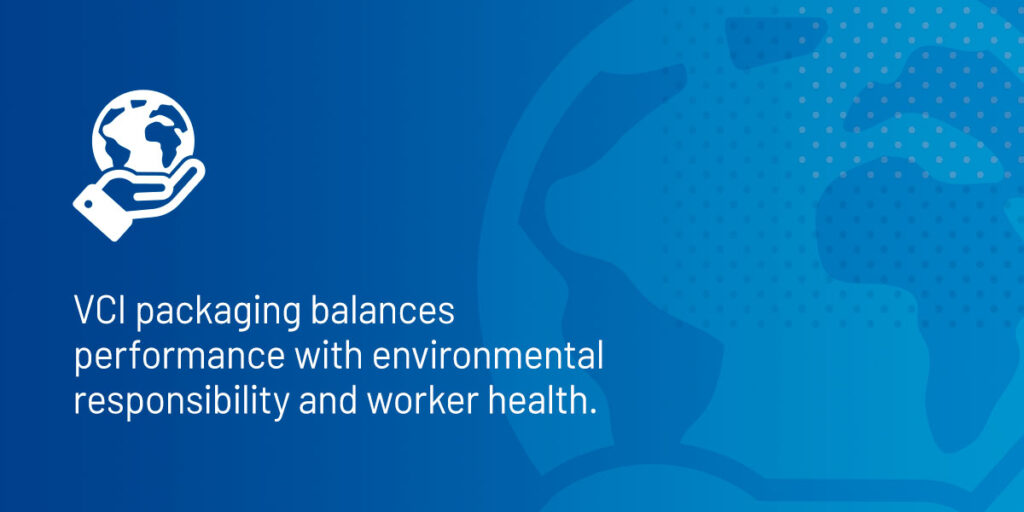
Environmental Impact
VCI packaging materials have environmentally friendly rust protection features. Many products are biodegradable or made from recycled content, ensuring that packaging can be disposed of responsibly after use.
Lightweight formats reduce shipping weight, indirectly lowering transport emissions. Because VCI packaging reduces the need for oils, greases or excessive desiccants, it minimizes reliance on materials that pollute soil or waterways.
These sustainable practices meet internal corporate goals and align with customer and regulatory expectations. Companies that adopt environmentally conscious packaging solutions show a forward-thinking approach that enhances their brand reputation.
Safety Profile
Traditional corrosion prevention methods often require handling petroleum-based products or solvents, which involves exposure risks. VCI packaging eliminates most of these concerns. The chemicals used are nontoxic at the levels released, making them safe for workers to handle.
Many VCI products meet international safety standards and avoid classification as hazardous materials. Compared with oil and coatings, which can be flammable or require ventilation controls, VCI packaging is a cleaner and more user-friendly option.
Implementation and Best Practices
Adopting VCI packaging is most effective when businesses align product selection and handling with their operational and regulatory requirements. Proper implementation ensures the full benefits of corrosion protection.
Selection Criteria
Choosing the right VCI solutions begins with an assessment of material compatibility. This includes:
- Material selection: Ferrous and nonferrous metals may require different formulations to ensure optimal protection without side effects.
- Environment assessment: Facilities located in coastal regions may face higher salt exposure and humidity, making higher-barrier VCI films or multilayer papers more appropriate.
- Duration requirements: Industry federation or military requirements dictate specific packaging standards. Meeting industry benchmarks ensures packaging provides effective protection and passes audits and inspections.
- Cost considerations: Long-term savings outweigh the upfront investment. Businesses should compare different packaging formats to balance expense and operational efficiency.
Application Guidelines
Once the correct materials are chosen, success depends on controlled packaging practices. Consider the following:
- Proper packaging techniques: Metals should be clean, dry and free from existing rust before being enclosed in VCI packaging. Wrapping or sealing must eliminate unnecessary gaps so that vapor distribution forms a uniform protective layer.
- Storage conditions: Storing items indoors, away from direct sunlight or wide temperature swings, extends the life of VCI protection.
- Monitoring and maintenance: Regular monitoring and upkeep, such as inspecting packaging integrity, enhances reliability.
- Quality control: Incorporating quality control checkpoints ensures packaging consistency and maintains confidence that every protected asset will arrive or remain in a corrosion-free condition.
VCI Packaging Cost-Benefit Analysis
VCI packaging supports financial strategies and helps businesses achieve long-term value. Here’s how the solution pays off.
Economic Benefits
VCI packaging helps control costs through:
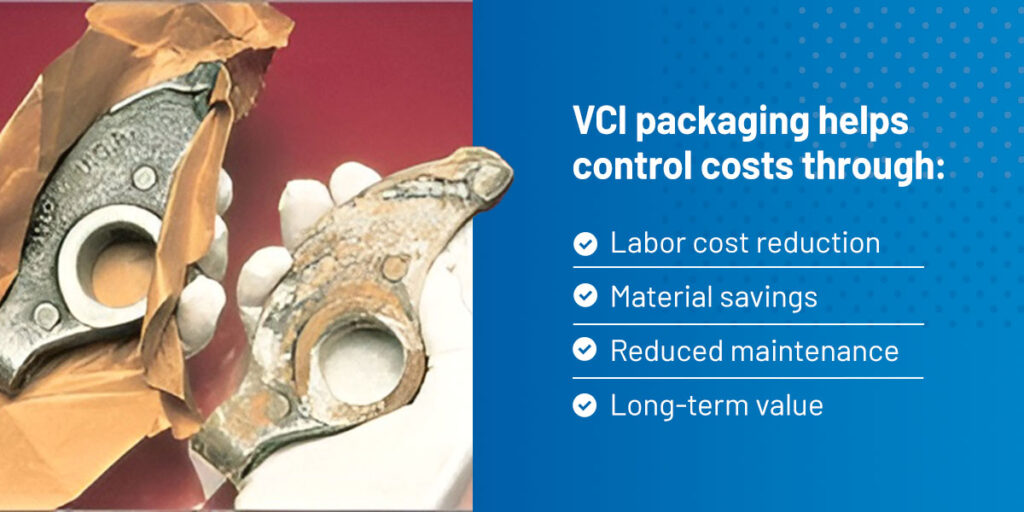
- Labor cost reduction: One of the most immediate gains is labor cost reduction. Unlike oiling or greasing methods that require manual application and later removal, VCI packaging is quick to deploy and reduces cleanup.
- Material savings: Material savings accumulate as companies use less petroleum-based products, fewer desiccants and reduced volumes of secondary packaging.
- Reduced maintenance: Maintenance costs decline because corrosion-related failures are prevented before they occur. Equipment preserved with VCI requires less reconditioning and fewer replacement parts.
- Long-term value: The cost of implementing VCI is often a fraction of the expense of repairing or replacing corroded inventory or delayed shipments.
Performance Benefits
Beyond economics, performance improvements strengthen business outcomes. Notable ones include:
- Protection reliability: VCI packaging delivers reliable, consistent protection that adapts to varied conditions.
- Time savings: Its ease of use translates to time savings. Workers can package components without needing specialized skills or gear.
- Quality improvement: Finished products arrive at their destination free of rust, which supports customer satisfaction and precision performance.
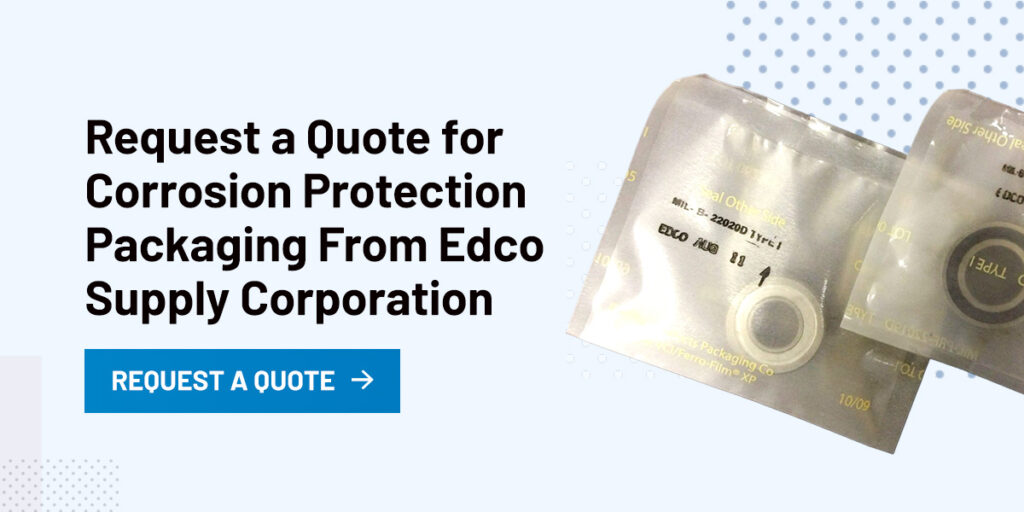
Request a Quote for Corrosion Protection Packaging From Edco Supply Corporation
Edco Supply Corporation has over 60 years of experience supplying military specification packaging to various industries across Canada and the U.S. We maintain a large inventory of VCI packaging, allowing us to deliver fast lead times and dependable availability.
Our team customizes solutions to meet the requirements of your storage environment and shipping conditions. We provide detailed documentation and certificates of compliance, giving you confidence that every order aligns with Department of Defense and industry standards.
Request a quote today for metal packaging protection solutions.


